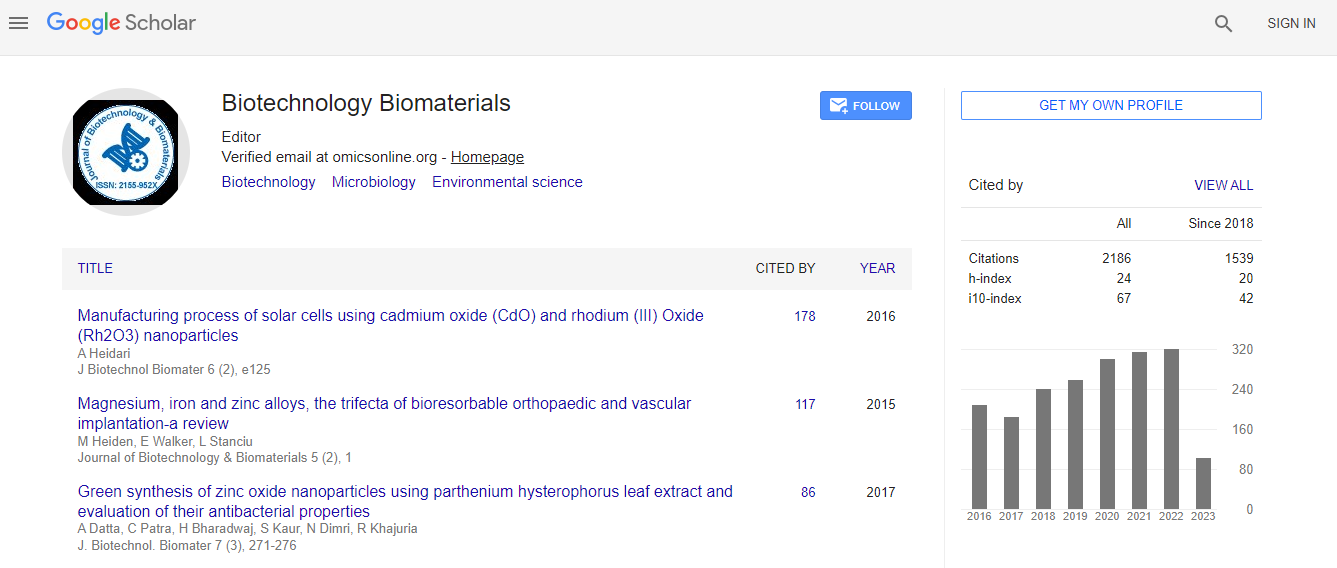Our Group organises 3000+ Global Conferenceseries Events every year across USA, Europe & Asia with support from 1000 more scientific Societies and Publishes 700+ Open Access Journals which contains over 50000 eminent personalities, reputed scientists as editorial board members.
Open Access Journals gaining more Readers and Citations
700 Journals and 15,000,000 Readers Each Journal is getting 25,000+ Readers
Google Scholar citation report
Citations : 3330
Journal of Biotechnology & Biomaterials received 3330 citations as per Google Scholar report
Indexed In
- Index Copernicus
- Google Scholar
- Sherpa Romeo
- Open J Gate
- Genamics JournalSeek
- Academic Keys
- ResearchBible
- China National Knowledge Infrastructure (CNKI)
- Access to Global Online Research in Agriculture (AGORA)
- Electronic Journals Library
- RefSeek
- Hamdard University
- EBSCO A-Z
- OCLC- WorldCat
- SWB online catalog
- Virtual Library of Biology (vifabio)
- Publons
- Geneva Foundation for Medical Education and Research
- Euro Pub
- ICMJE
Useful Links
Recommended Journals
Related Subjects
Share This Page
Synthesis and self-assembly of bacteriophage like particles in yeast: Novel molecular toolboxes
23rd International Conference on Pharmaceutical Biotechnology
Aliona Spakova, Raminta Batiuskaite, Rasa Petraityte-Burneikiene, Eugenijus Simoliunas, Lidija Truncaite, Vida Casaite and Rolandas Meskys
Vilnius University Life Sciences Center, Lithuania
ScientificTracks Abstracts: J Biotechnol Biomater
Abstract
Statement of the Problem: Current vaccines against infectious diseases have primarily relied on attenuated or inactivated pathogens. However, virus like particles (VLP) are used as vaccine platforms which are more favorable for their perfect defined structures; induction of strong immune response and also suitable for surface decoration by inserted foreign epitopes. While many icosahedral VLPs are synthesized in bacteria and the disadvantages such as lack of post-translational modifications are needed for eukaryotic proteins and contamination of purified VLPs with bacterial endotoxins are encountered. While icosahedral VLP platforms have been studied in detail but rod-shaped VLPs have been mostly forgotten. Until now, there is no information regarding the generation of tailed bacteriophage nanotubes in yeast. Aim: The research aims to generate nanotubes using yeast expressed bacteriophage tail proteins and determine their tolerance for genetic introduction of foreign epitopes. Methodology: DNA sequences coding tail proteins of bacteriophages NBD2, FV3 as well as RaK2 were cloned into yeast protein expression vectors. Synthesis of phage proteins was confirmed by protein electrophoresis and rod-shaped structures were analyzed by electron microscopy. Findings: Our work has focused on developing an alternative epitope presenting rod-shaped platform which could be used for biomedical applications. To our knowledge, it is the first attempt to produce bacteriophage originated nanotubes in yeast cells which determines their tolerance for genetically incorporated foreign epitopes. Yeast protein synthesis system allowed efficient generation of long and flexible nanotubes originated from NBD2 tailed bacteriophage as well as tubes with different morphology from RaK2 and FV3 phages. Conclusion & Significance: This work intends to show the suitability of yeast protein synthesis system to generate high yields of nanotubes that originate from tailed bacteriophages. The novel strategy presented here could provide safer vaccine candidates compared to the VLPs synthesized in bacteria. Recent Publications 1. Kaliniene L, Truncaitė L, Šimoliūnas E, Zajančkauskaitė A, Vilkaitytė M, Kaupinis A, Skapas M and Meškys R (2018) Molecular analysis of the low-temperature Escherichia coli phage vB_EcoS_NBD2. Archives of Virology 163(1):105-114. 2. Schoonen L and van Hest J C (2014) Functionalization of protein-based nanocages for drug delivery applications. Nanoscale 6(13):7124-41. 3. Zeltins A (2013) Construction and characterization of virus-like particles: a review. Mol Biotechnol. 53(1):92-107. 4. Jennings G T and Bachmann M F (2008) The coming of age of virus-like particle vaccines. Biol Chem. 389(5):521-36. 5. Trivedi B, Valerio C and Slater J E (2003) Endotoxin content of standardized allergen vaccines. J Allergy Clin Immunol. 111(4):777-83.Biography
Aliona Špakova is a PhD student at Life Sciences Center, Institute of Biotechnology-Vilnius University. Her research aims at generation of novel bacteriophage tail tube originated yeast expressed nanotubes as novel epitope presenting platforms.
E-mail: aliona.spakova@bti.vu.lt

 Spanish
Spanish  Chinese
Chinese  Russian
Russian  German
German  French
French  Japanese
Japanese  Portuguese
Portuguese  Hindi
Hindi 
